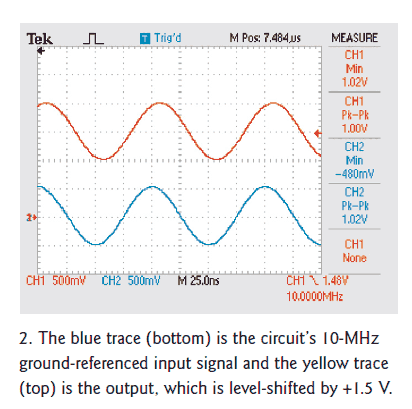Non-Inverting Level Shifter : +/-5V signal into a 0 to 3.3V
With portable battery-operated devices continuing to add functionality while shrinking in size, printed-circuit-board real estate becomes increasingly valuable. Single-supply circuitry can help by saving space and cost. Adding audio or video, however, may pose a problem because those signals are usually referenced to ground, and most single-supply ICs must be configured for signals above ground.
Therefore, the circuit must shift most audio or video input signals to an appropriate level above ground. Also, polarity must be preserved for video signals. Unfortunately, using a single-supply voltage while preserving signal polarity is impossible with traditional op-amp level shifters, which require two op amps and a negative rail.
The circuit in Figure 1 meets all of these requirements, level-shifting a ground-referenced signal with one op amp while running on a single-supply voltage. The op amp’s non-inverting summing configuration creates the level-shifted output by summing a reference voltage with the input signal. A standard potentiometer with a bypass capacitor sets the reference voltage, but any voltage reference able to provide enough bias current for the op amp and summing resistors will suffice.
This example circuit includes the 75-Ω termination resistors required in a standard video application. The op amp shown features a small footprint plus the wide bandwidth needed for video. Figure 2 shows the circuit’s operation, shifting a 10-MHz ground-referenced input signal by +1.5 V.


http://www.daycounter.com/Calculators/Op-Amp/NonInverting-Op-Amp-Resistor-Calculator.phtml
A common engineering task is to convert a positive to negative signal into a range suitable for a single supply ADC.
This circuit will convert a +/-5V signal into a 0 to 3.3V signal so that it can be sampled by an ADC on a 3.3V microprocessor.

Equations:
A = (R4/R1) x (R1+R2)/(R3+R4)
If R1= R3, and R2=R4, then
A= (R4/R1)
We want to convert a 10Vpp signal to a 3.3V signal so the gain should be 1/3. We can choose R4 to be 33K and R1 to be 100K.
Now we need to choose the positive offset such that the signal is centered at 1.6V.
The gain off the offset voltage is:
Aoffset= (R2+R1)/R1 x R3/(R3+R4) = R3/R1.
For the previous resistor values, the gain is 1 since R3=R1, and so we use an offset voltage of 1.6V.
http://www.daycounter.com/Calculators/Op-Amp/NonInverting-Op-Amp-Resistor-Calculator.phtml

This calculator determines the bias and feedback resistors for a non-inverting op-amp, given the gain and desired output bias point.
There are many free parameters to the design so enter the value of R1, which will scale the other resistors.
Use V1 as the input for the inverting Op-Amp, and V2 as a voltage offset if needed.
Set V2 to zero if no offset is required.
To use the calculator you first need to determine the desired gain of the ac signal,
and the quiescent output voltage (the value when the AC input signal is zero).
R4 injects a non-zero V2 voltage component into the circuit and correspondingly offset Vout.
Another way of looking at it is, if V2 is zero and the DC component of V1 is zero then Vout will also be zero.
The amplified output signal will ride on the quiescent output voltage.


